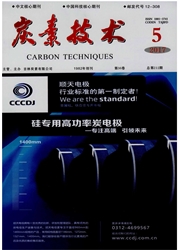

 中文摘要:
中文摘要:
化学气相渗透技术是制备高性能C/C复合材料的一种重要方法。采用均热式CVI炉,对400℃不同压力下制备的泡沫炭进行化学气相渗透。分析了泡沫炭在CVI处理中的沉积过程,通过SEM观察了泡沫炭沉积形貌和热解炭的微观结构,测试了材料的力学性能。结果表明:利用CVI工艺能在较短的时间内对泡沫炭进行有效的致密,降低显气孔率。其中400℃,5MPa条件下制备的泡沫炭,CVI前后显气孔率下降最明显,由77.7%降到55.6%,降幅达到近30%;体积密度在CVI前后也显著增大,在400℃,5MPa条件下,由最初的0.434g/cm^3增大到0.825g/cm^3,增大0.9倍以上。泡沫炭基体中沉积一定量的热解炭,可以显著提高泡沫炭的抗压缩强度。400℃,4MPa制备条件下,CVI前后压缩强度增大将近6倍。
 英文摘要:
英文摘要:
Chemical vapor infiltration processing (CVI) are considered as the most important technique for fabrication of carbon/carbon composites. The carbon foams , prepared under 400℃ and different pressures, were infiltrated with. an isothermal chemical vapor infiltration(CVI)furnace and the process was analyzed. The morphology and the microstructure of pyrolytic carbon were observed with scanning electron micrograph (SEM), and the mechanical performances were also tested. The results show that the density of carbon foam treated by CVI increase effectively in a short time, and the apparent pore ratio of the carbon foam reduce. The apprent porosity of the carbon foam prepared at 400 ℃. under 5 MPa declines from 77.7% to 55.6%, the bulk density increases from 0. 434 g/cm^3 to 0. 825 g/cm^3. The pyrolytic carbon, infiltrated in the carbon foam , can obviously enhance the compressive strength of the carbon foam. The compressive strength of the carbon foam with CVI treatment at 400 ℃ under 4 MPa increases almost 6 times.
 同期刊论文项目
同期刊论文项目
 同项目期刊论文
同项目期刊论文
 期刊信息
期刊信息
